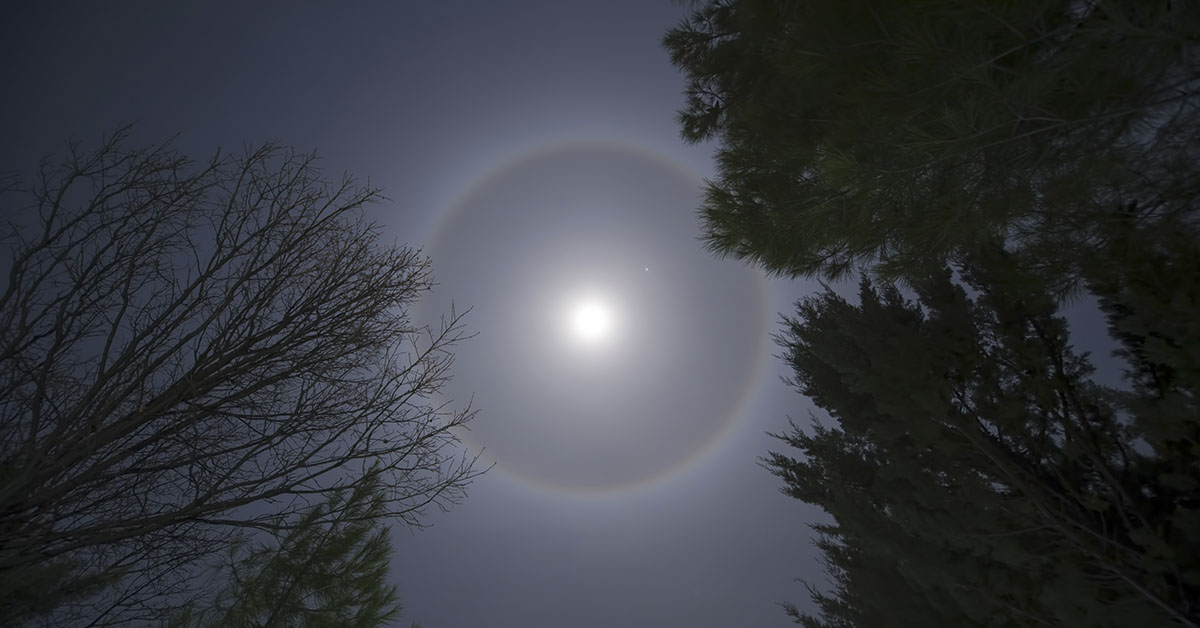The moon’s halo, also known as a lunar halo, is a captivating optical illusion that creates a large bright ring around the moon. This beautiful spectacle occurs due to the refraction of moonlight by ice crystals present in the upper atmosphere.
These suspended or falling ice crystals act as a giant lens producing arcs and halos around the moon during the night or the sun during the day. The phenomenon has inspired a wealth of folklore and superstitions, with some using it to predict bad weather.
How does a lunar halo even occur?
Lunar halos are formed when light passes through ice crystals suspended in cirrus or cirrostratus clouds at high altitudes, ranging from 20,000 to 40,000 feet. The hexagonal shape of these ice crystals focuses light into a halo around the moon or the sun. With the moon typically sitting about 22 degrees from the edge of the halo.
The uniform 22-degree radius and 44-degree diameter of the halos have led to them being commonly referred to as 22-degree halos. This consistency is due to the specific index of reflection for ice and the 60-degree apex angle of the hexagonal ice crystals resulting in a minimum deviation angle of 21.84 degrees.
Read: This Bioluminescent See-Through Kayak Tour Takes You To Another World
Almost rainbow-like in appearance, this ring around the moon is quite impressive

The ice crystals also create a prism effect, dispersing white light into individual colors, creating a ring around the moon, much like how a rainbow is formed in the atmosphere. As a result, lunar halos may exhibit faint rainbow colors, with red on the inside and blue on the outside. However, they are often too subtle to be seen with the naked eye.
The optical properties of the ice crystals mean that they don’t direct light back toward the center of the halo creating the appearance of a “hole in the sky” inside the 22-degree halo. Additionally, lunar halos are often accompanied by smaller, more colorful rings caused by the refraction and reflection of light by water molecules known as coronas.
In some instances, refraction from ice crystals can produce double halos with spokes radiating outward. Moreover, the same icy refractive effect can create rings and pillars of light around other astronomical bodies, such as the sun. Leading to various optical phenomena like “sun dogs.”
Read: Lunar And Solar Eclipses 2023 – Dates, Folklore, And Facts
Observing lunar halos can be a delightful experience
They are more likely to be visible during winter when the moon is full or nearly full and veiled by thin cirrus clouds. These transparent clouds cover large areas of the sky. Producing various other halo effects like white or colored rings and arcs of light, essentially, a ring around the moon.
Hailed in folklore, they are shrouded in tradition
In folklore, the observation of a lunar halo has been associated with forthcoming unsettled weather, particularly during winter. Cirrus clouds, often responsible for lunar halos, can indicate an approaching warm front and a low-pressure system. Leading to storms with significant temperature drops, heavy rain, hail, and thunder.
However, it’s worth noting that while folklore has used lunar halos to predict the weather, this method isn’t entirely reliable as cirrus clouds may not always indicate bad weather. Also, the idea of counting stars encircled by the halo to predict the timing of bad weather is not scientifically accurate and should be viewed with skepticism. Overall, lunar halos offer a magical sight to behold. And while they may be associated with weather folklore, they are a product of the intricate interplay between light and ice crystals in the atmosphere.
Keep Reading: Rare Breathtaking ‘Rainbow Halo’ Looks Like Portal To Another Dimension
Sources
- What is a moon halo?” Space. Robert Lea. November 28, 2022
- “Ring Around The Moon? Here’s What It Means.” Farmers’ Almanac. April 17, 2023

